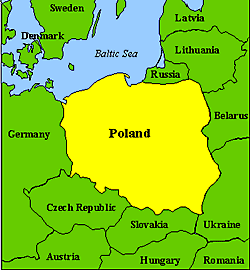Polish

Number of
speakers: 43
million
Key dialects: Wielkopolska, Malopolska,
Geographical center:
Educational
Resources: Many
Proficiency Tests
GENERAL
INTRODUCTION
Polish is spoken by about 43 million people of whom
some 36.5 million speakers live in
LINGUISTIC
AFFILIATION
Polish is a Slavic language and belongs to the West
Slavic subgroup, which also includes Czech, Slovak, Cassubian (spoken in
the Baltic coast region in northern
Slavic languages--together with the Baltic languages,
Latvian and Lithuanian--form a branch of the Indo-European family. Other
Slavic subgroups are South Slavic (Old Church Slavonic, Slovene, Serbian,
Croatian, Bulgarian) and East Slavic (Russian, Ukrainian, Belarusian).
LANGUAGE VARIATION
Dialect variation corresponds to
historical-geographical regions in
ORTHOGRAPHY
Polish uses a Latin-based
alphabet, introduced in the tenth century with Christianity. It contains
numerous diagraphs, and uses diacritics on certain consonants and vowels.
Some variation exists in the spelling of some sounds.
LINGUISTIC
SKETCH
Polish is a richly inflected language like other Slavic
languages. Nouns which are feminine, masculine, and neuter are declined in
four declensions, and adjectives agree in number, gender, and case. Number
(singular and plural) is distinguished as is gender by inflectional
endings on stems. The seven inflectional cases are nominative, accusative,
genitive, dative, instrumental, locative, and vocative. Polish also marks
an animate/inanimate distinction where nominals referring to humans and
animals are distinguished inflectionally within the case system from nouns
and adjectives that are not. Another distinction in the case system is
between masculine personal and non-masculine personal nouns and
adjectives.
Verbs have four conjugations distinguishing first,
second, and third persons, singular and plural; thus independent personal
pronouns are used only for emphasis. There are, however, honorific second
person pronouns which are used with third person forms of the
verb.
In syntax, main verbs agree in person and number with their
subjects. Adjectives agree in person, gender, and case with the noun they
modify. One of the prominent features of the system of agreement is a high
degree of redundancy: the same gender and number information may be
repeated several times in the sentence.
Word order is grammatically
free with no particular fixed order for constituents marking subject,
object, possessor, etc. However, the neutral order is Subject-Verb-Object.
The inflectional system takes care of keeping clear grammatical relations
and roles. Pragmatic information and considerations of topic (what the
sentence is about, or old information) and focus (new information conveyed
by the sentence) as in other Slavic languages, is important in determining
word order. Topics precede constituents that are in focus.
Modern
Polish has seven vowel phonemes, two of which are nasalized, and a rich
consonantal system of thirty-five phonemes. Characteristic is the three
sets of affricates and double consonants. Voiced consonants at the end of
words are devoiced. Stress is on the penultimate syllable in most Polish
words; exceptions are usually loans from Latin and Greek.
Polish
has borrowed extensively from German and Yiddish, and there is some
borrowing from East Slavic languages. Other languages contributing lexis
have been Latin, Czech, Lithuanian, French, and Italian.
ROLE
IN SOCIETY
After the end of WWII with readjustment of borders,
Standard Polish, or
variants which closely approximate the standard, is the variant spoken by
most urban dwellers. It is the official language of government, media,
administration, and education. In rural areas away from large urban areas
local dialects are the norm in casual social interaction; in more formal
situations code-switching between rural modes and the standard forms of
speech is common. Nevertheless, nonstandard features have low prestige,
but in a few areas (
In schools, English and
German are the more popular of the foreign languages being taught; Russian
is still the more widely available choice although no longer
compulsory.
HISTORY
The earliest evidence for Polish
comes from various sorts of names for persons, places and tribes recorded
in medieval Latin documents going back to the ninth century. From then
until the fourteenth century other attestations can be found in other
Latin texts, but these are mostly single lexical items. In the fourteenth
century whole texts in Polish begin to appear, the earliest being
religious in nature, for example, a collection of sermons and a
translation of the Psalms. Medieval Polish is well attested through court
depositions where reported speech is recorded in Polish. Portions of the
Bible were translated by the middle of the fifteenth century. Some of
these early texts exhibit a rudimentary standardization process. Printing
arrived in 1513 and with it greater standardization of spelling. The
sixteenth century--the Golden Age of Polish literature--saw the first
printing of dictionaries, grammars, and spelling guides.
ACADEMIC RESOURCES
Over 50 institutions in
REFERENCES
Campbell, G. L. 1991.
Compendium of the World's Languages, Vol. 1 -2.
Comrie, B.
1987. "Slavonic Languages." In B. Comrie, ed. The World's Major Languages,
pp. 322-328.
_____.
1992. "Slavic Languages. In W. Bright, ed. International Encyclopedia of
Linguistics, Vol. 3:452-455.
Grimes, B.
F., ed. 1992. Ethnologue, Languages of the World.
Guild, D. G. 1994. "Polish." In R. E. Asher, ed. The
Encyclopedia of Language and Linguistics, Vol. 5:3205-3206.
Linguistic Society of
Mazur, B. W.
1994. "
Rothstein,
R. A. 1993. "Polish." In Comrie, B. and G. G. Corbett, eds. The Slavonic
Languages, pp. 686-757.
Ruhlen, M. 1987. A Guide
to the World's Languages, Vol. 1: Classification.
Stone, Gerald. 1987. "Polish." In B. Comrie, ed. The
World's Major Languages, pp. 348-366.